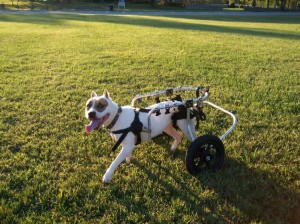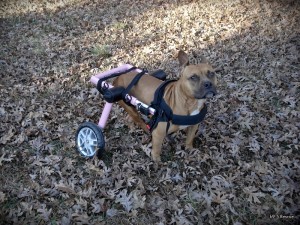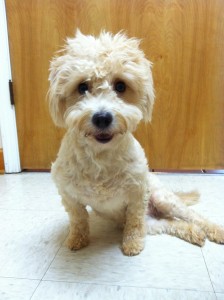I am often questioned on how I manage having a dog in a wheelchair, and understandably people ask in a slightly exasperated tone, “Is it hard?” I’d be dishonest if I said there weren’t times when I didn’t want to pull my hair out, but let’s be honest…who doesn’t make us want to scream out obscenities from time to time? Husbands, wives, children, parents…shall I go on?
Sure, at first it’s easy to be overwhelmed. It’s an alteration to your life, a change in habit, and there’s a lot to learn. That doesn’t mean it has to be debilitating, however. In fact, it can be just the opposite.
China, our first dog in a wheelchair, was a paraplegic (back legs were paralyzed), incontinent, had allergic reactions to some cleaners, and mainly dragged herself around. She was happy, energetic, affectionate, playful, and had every intention of enjoying her life…and she did, so far be it for me to interfere. Over time she became more ataxic than paralyzed and would stand or run, but overall she pulled herself around more. This was because it was easier for her; she’d developed phenomenal speed. She was cut like Mr. America and from the waist up was as agile as a deer. So dragging didn’t phase her in the slightest.
Her incontinence was the hardest part, although as time passed she most often knew when she had to go to the bathroom. The problems were worst, however, when I didn’t follow routine due to my own schedule or being scatterbrained, or when I didn’t listen to her. Her body processed food and water slower, most likely because she wasn’t as active as a non-paralyzed dog, so she had a different potty regimen. When I didn’t pay attention, she just couldn’t hold it. However, we managed to find our own routine together, and when I stuck to it we rarely had accidents. When I faltered even slightly I found myself cleaning. It wasn’t fun, I won’t lie, but it wasn’t because she was a bad dog. The fault fell on me more often than not.
Nyla has been a bit easier. She has more function in her legs and has made great progress, most likely b/c her injury is not as extensive as China’s…China had a lot of nerve damage. However, Nyla still walks around like the town drunk and falls on occasion…or when she’s tired of walking. She does have accidents, but identical to China, it’s due to my stepping off schedule.
Nyla at this point is going up and down stairs (not necessarily gracefully, but she’s doing it and doing it better every day), hanging out with the dogs for some play time outdoors on pretty days, letting me know when she has to go potty, actually going potty on her own, and so forth. She has come great distances in a short time. We still have accidents from time to time, but for the most part we’re good to go with the potty schedule.
She’s just like China in the sense that she’s utterly adorable, playful, goofy, affectionate, happy, determined, and so on and so forth. It’s nice to have her around…and, of course, I adore that little brown nugget like there’s no tomorrow.
The first time you have a dog in a wheelchair you feel like a student. By the second, you’re an old pro. There are things that you adjust to, things you pick up on, and things you find helpful or far from helpful, and you tuck that information away in the back of your mind for safe keeping. When the next one comes along, you apply it and say to yourself, “Piece of cake.”
So let me share with you what I’ve learned with the hope that if you’re reading this and have a dog in a wheelchair, or are considering adopting one, it will be of some assistance:
- Don’t baby them too much. They don’t want restrictions. They are still happy, playful pups and when Mom interferes it’s annoying (think teenager). On the flip side, they also need to know that despite having a handicap, they are not allowed to be expectant brats, they won’t always get their way, and there are still rules to follow.
- Baby the heck out of them. These dogs need to know that they are not different. They are still special, still adored, and still your sweetie. This type of “babying” is encouraging to them because they know you’re not upset with them (esp after a potty accident), and they know that even though they do things a little funny now, it’s okay and doesn’t matter to you because it’s unconditional love. China had the most pitiful, bring you to tears look when she had an accident. She looked as if she was going to cry. Stabbed you right in the heart…about five times. All you could do was give her a hug and a kiss so that you’d both feel better.
- Push them as far as you can. The body, human or animal, responds to being exercised when its in a passive state because activity encourages strength and blood flow. Make them get up and get a treat vs. always taking it to them. Make them try to walk. Work those legs and show them how to use them.
- Don’t push them into dangerous territory. Be wise. Don’t expect them to handle dogs the same way during introductions, playtime, etc. They can still meet and interact with other dogs and have a good time, but if things get too rowdy it can lead to fear or dominance while playing. Don’t try to make them walk a flight of 12 stairs. You can encourage a few steps, but walking up to the 2nd floor is most likely going to be difficult and could put unnecessary strain on the spine. Do not put them in any sort of situation that could pose detriment.
- Listen to the dog. If a dog gives a look or a movement, or even scadaddles toward the door, pay attention. Let them show you what they need. They don’t always show pain due to lack of physically feeling it or simply being immune to discouragements, so if you receive a look that is “off,” be safe and visit a veterinarian. If trying something frightens them, provide assistance and let them know it will be safe. If they like one type of bed over another, by golly, give them the one they adore.
- Don’t give up on them. It may seem disheartening or impossible to you, but animals have a different attitude. Don’t misinterpret a disability as being dead.
- Baby mattresses are perfect beds. Suggested by a veterinarian/friend of mine, baby mattresses from a second-hand store are fantastic beds for paralyzed or ataxic dogs because they are super easy to clean and it gets them off of the floor.
- They love enormous stuffed toys – ENORMOUS stuffed toys. You know the gigantic children’s stuffed animals you see in the aisles that boast a head the size of 5 footballs on to flopsy, pillowed torsos, legs and arms? Those. They often come in bears, ducks, pandas, etc. I don’t know what’s so charming about them (outside of being super cute), but it appears that they’re a snuggle buddy or their baby…not to mention that they’re soft and cushy which is always nice.
- Crates may or may not be needed. While true for most any dog, in regard to wheelchair dogs it relates to their incontinence. If you think there’s the slightest chance of an accident, use a larger than needed crate (plastic is best) so that it won’t go all over your car yet will provide room for the dog to get out of the mess. Put a thick towel or two inside the crate to lie on (and always carry extra). If necessary it can collect the urine or feces until you can reach a stopping point to clean the crate. *Do not leave the dog in the crate any longer than necessary. Urine can burn the skin, and feces…well, that’s pretty self explanatory.
- You can take them anywhere. Just because they are a handicapped dog does not mean they don’t like to travel or don’t travel well. They still enjoy outings, visiting friends, family, and just spending the time going somewhere with you. These days wheelchairs fold up and even fit in a small, lightweight travel bag for easy transport (think “green,” reusable shopping bags).
- You don’t spend all of your time a the vet. Handicapped doesn’t equal “constantly sick,” so there won’t be consistent veterinary visits. It is not uncommon to have a few more urinary tract infections than most dogs, simply from being on the ground so much or having difficulty emptying the bladder completely, but they are not continual. Sometimes you may need to doctor some pressure sores, but again, not a constant.
- Be flexible while being prepared. Be knowledgeable that there will be accidents when you’re already running late and flying out the door. There will be a need to clean on occasion when you’re wearing a new outfit. Use your routine, experience and common sense to help you prevent those situations, and for the most part you’ll be able to do so.
- Don’t have a weak stomach. There will be poop, pee, and possibly some ugly sores. You may even need to assist the dog with pottying (nothing gross, just pressure on the bladder). It’s only poop and pee…you do it, too.
- Develop a routine and stick with it. Routines and schedules are a huge factor in preventing potty accidents. It helps your dog to train his or her body while also allowing you to be punctual with your activities (e.g. work, appointments, dinners)…meaning, less unexpected accidents while you’re trying to get ready.
- Paper towels and Clorox will be regular purchases. Buy an empty spray bottle at your local hardware store or in the cleaning department of a department store. Fill 1 part Clorox to 9 parts water, and if there’s an accident use it for cleaning and sanitation. My favorite paper towels for this sort of clean up are Brawny. They are strong and thick. I’ve used the Target brand with satisfaction, and even Walmart/Sam’s brand. I love Viva but they are luxurious and almost too costly for cleaning accidents. Brawny is a super, super paper towel. I prefer it over Bounty or any others.
- Baby wipes are GREAT. It’s not always feasible or good to bathe a dog too often. With a dog who could potentially have accidents while sleeping or traveling, baby wipes allow you to clean up the dog without giving an entire bath. Any brand, any scent, as long as there is no allergic reaction to the ingredients.
- Dog wheelchairs last forever. They are made well, and they are sturdy; A worthwhile investment. They can also be donated later to another dog or a rescue/sanctuary that takes in dogs who are unable to walk.
- Don’t believe your life will be miserable. If there’s only one thing I can stress to you, it’s this. You are not going to be struggling and crying out for relief, as long as you can physically handle lifting and walking the dog (*This is something you’ll want to take into consideration. Lifting giant breed dogs may not be an option for you). You are not going to lose the dog you once knew and end up looking at him or her as a burden…IF you choose not to and accept that things are different. Not bad, but different. You can enjoy your dog just as much as always…perhaps even more so. Working closely with your handicapped dog forms a strong bond that you never knew existed.
Now let me insert sweet little Tippy here. I thought Tippy would be a wheelchair dog, but she proved me to be an idiot. Tippy was thrown over a shelter fence and landed on concrete. This resulted in nerve damage, a funny walk, and a hip out of socket. Tippy never, ever stopped. She walked, ran, stood, climbed…you name it. No wheelchair for Tippy because she wanted no part of it. She, goddess that she was, would settle for nothing less than walking, even if she did look like she’d been on a week long vodka stint. In time she most likely would have needed a wheelchair, but we didn’t want to offend her so we never told her of our assumption.
We lost sweet Tippy sooner than we could have ever expected at the young age of 1.5-2yrs old. The cause is unknown, and it happened in less than 24 hours. You can read her story here.
If you ever find your dog is in need of a wheelchair due to paralysis or a spinal issue (e.g. degenerative myelopathy), then don’t be discouraged. Talk to your veterinarian about how you can live happily with your dog. Contact rescues, sanctuaries and other owners via various websites for handicapped dogs to get ideas about making things easier for everyone. There are too many wonderful reasons that your dog can continue on with his or her life…mainly its burning desire to keep on living. 🙂
*Visit our website’s Links page for other websites that focus on handicapped dogs.


